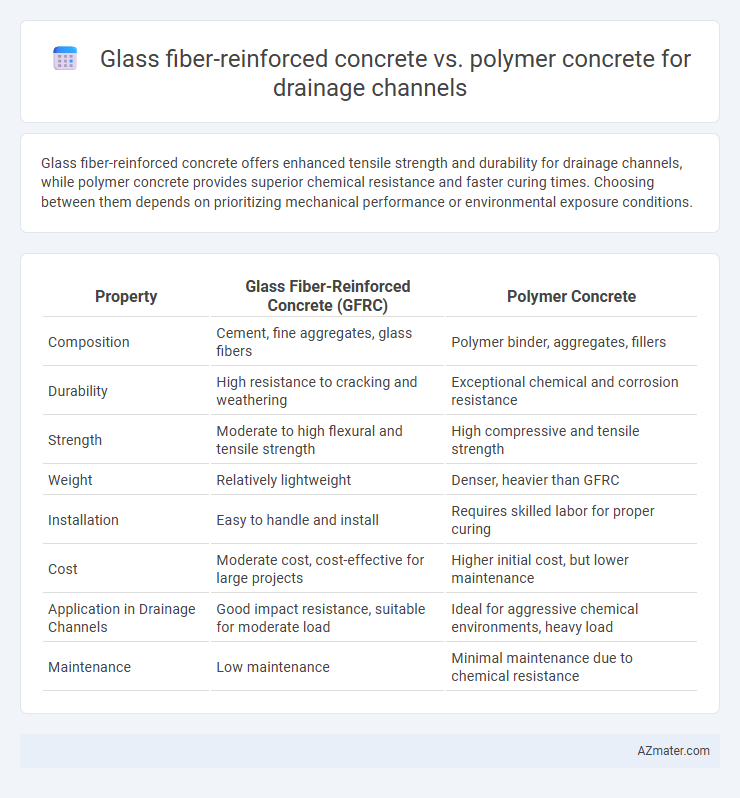Glass fiber-reinforced concrete offers enhanced tensile strength and durability for drainage channels, while polymer concrete provides superior chemical resistance and faster curing times. Choosing between them depends on prioritizing mechanical performance or environmental exposure conditions.
Table of Comparison
| Property | Glass Fiber-Reinforced Concrete (GFRC) | Polymer Concrete |
|---|---|---|
| Composition | Cement, fine aggregates, glass fibers | Polymer binder, aggregates, fillers |
| Durability | High resistance to cracking and weathering | Exceptional chemical and corrosion resistance |
| Strength | Moderate to high flexural and tensile strength | High compressive and tensile strength |
| Weight | Relatively lightweight | Denser, heavier than GFRC |
| Installation | Easy to handle and install | Requires skilled labor for proper curing |
| Cost | Moderate cost, cost-effective for large projects | Higher initial cost, but lower maintenance |
| Application in Drainage Channels | Good impact resistance, suitable for moderate load | Ideal for aggressive chemical environments, heavy load |
| Maintenance | Low maintenance | Minimal maintenance due to chemical resistance |
Introduction to Advanced Drainage Channel Materials
Glass fiber-reinforced concrete (GFRC) offers enhanced tensile strength and durability for drainage channels, making it resistant to cracking and environmental degradation. Polymer concrete, composed of resin binders and aggregates, provides superior chemical resistance and rapid curing, ideal for aggressive drainage environments. Both materials represent advanced solutions that improve the longevity and performance of drainage infrastructure compared to traditional concrete.
Overview of Glass Fiber-Reinforced Concrete (GFRC)
Glass fiber-reinforced concrete (GFRC) is a composite material that integrates alkali-resistant glass fibers into a cementitious matrix, enhancing tensile strength and durability for drainage channel applications. GFRC offers superior resistance to cracking and environmental deterioration compared to polymer concrete, making it ideal for long-term structural stability in harsh conditions. Its lightweight nature and excellent impact resistance contribute to easier installation and maintenance of drainage systems.
Overview of Polymer Concrete (PC)
Polymer concrete (PC) is a composite material composed of aggregates bound together with polymer resins, offering superior chemical resistance and rapid curing times compared to traditional cement-based counterparts. Its high durability, low permeability, and excellent adhesion make it ideal for drainage channels exposed to aggressive environmental conditions and corrosive fluids. PC's lightweight nature and reduced maintenance requirements enhance its suitability for infrastructure applications demanding longevity and efficiency.
Material Composition and Structural Properties
Glass fiber-reinforced concrete (GFRC) incorporates alkali-resistant glass fibers within a cementitious matrix, providing enhanced tensile strength, flexibility, and impact resistance ideal for drainage channels subjected to dynamic loads. Polymer concrete consists of a thermosetting resin binder combined with aggregates, offering superior chemical resistance, low permeability, and excellent bonding characteristics that improve structural integrity and longevity in corrosive environments. The cementitious base of GFRC delivers better thermal stability, while polymer concrete's matrix ensures higher resistance to aggressive chemicals and moisture, making each material suitable for specific drainage channel performance requirements.
Mechanical Strength and Durability Comparison
Glass fiber-reinforced concrete (GFRC) exhibits superior tensile strength and crack resistance compared to polymer concrete, making it more suitable for high-load drainage channels. Polymer concrete offers excellent chemical resistance and durability against aggressive environments, but its mechanical strength is generally lower than GFRC. Both materials provide enhanced longevity over traditional concrete, yet GFRC's balanced mechanical performance and durability make it the preferred choice for structurally demanding drainage applications.
Chemical Resistance and Corrosion Protection
Glass fiber-reinforced concrete (GFRC) exhibits excellent chemical resistance and corrosion protection in drainage channels due to its dense matrix and alkali-resistant glass fibers that prevent deterioration from acidic and alkaline substances. Polymer concrete outperforms GFRC in highly aggressive chemical environments by combining polymer binders with aggregates, offering superior resistance to acids, chlorides, and sulfates commonly found in industrial wastewater. Both materials provide durable solutions, but polymer concrete offers enhanced long-term corrosion protection in severely aggressive chemical exposure scenarios.
Installation Methods and Ease of Handling
Glass fiber-reinforced concrete (GFRC) offers improved workability and faster curing times, enabling more efficient installation in drainage channel projects due to its lightweight nature and flexibility in molding complex shapes. Polymer concrete, characterized by its chemical resistance and superior mechanical properties, requires specialized mixing and curing procedures, often making handling and installation more labor-intensive. The ease of handling GFRC allows for reduced labor costs and quicker deployment, whereas polymer concrete's robustness demands skilled labor and controlled conditions to ensure optimal performance in drainage applications.
Lifespan and Maintenance Requirements
Glass fiber-reinforced concrete (GFRC) offers a lifespan of 30 to 50 years with excellent resistance to cracking and chemical corrosion, resulting in reduced maintenance requirements for drainage channels. Polymer concrete provides superior chemical resistance and impermeability, extending service life to over 50 years while requiring minimal upkeep. Both materials enhance durability, but polymer concrete generally demands less frequent maintenance due to its enhanced resistance to harsh environmental conditions.
Cost Efficiency and Environmental Impact
Glass fiber-reinforced concrete (GFRC) offers superior cost efficiency for drainage channels due to its lower material and maintenance costs compared to polymer concrete, which relies on expensive resins and specialized fabrication processes. GFRC's environmental impact is reduced by its use of abundant natural materials and lower energy consumption during production, whereas polymer concrete involves petrochemical-based polymers that contribute to higher carbon emissions and end-of-life disposal challenges. The durability and recyclability of GFRC further enhance its sustainable profile in drainage infrastructure applications.
Best Applications for Each Material in Drainage Systems
Glass fiber-reinforced concrete (GFRC) excels in drainage channel applications requiring high tensile strength and abrasion resistance, making it ideal for heavy-load environments such as industrial or highway drainage systems. Polymer concrete offers superior chemical resistance and fast curing times, making it the best choice for harsh wastewater or chemical drainage systems where corrosion resistance is critical. Both materials provide durability and low maintenance, but GFRC is preferred for mechanical strength, while polymer concrete suits chemically aggressive conditions in drainage infrastructure.

Infographic: Glass fiber-reinforced concrete vs Polymer concrete for Drainage channel
 azmater.com
azmater.com